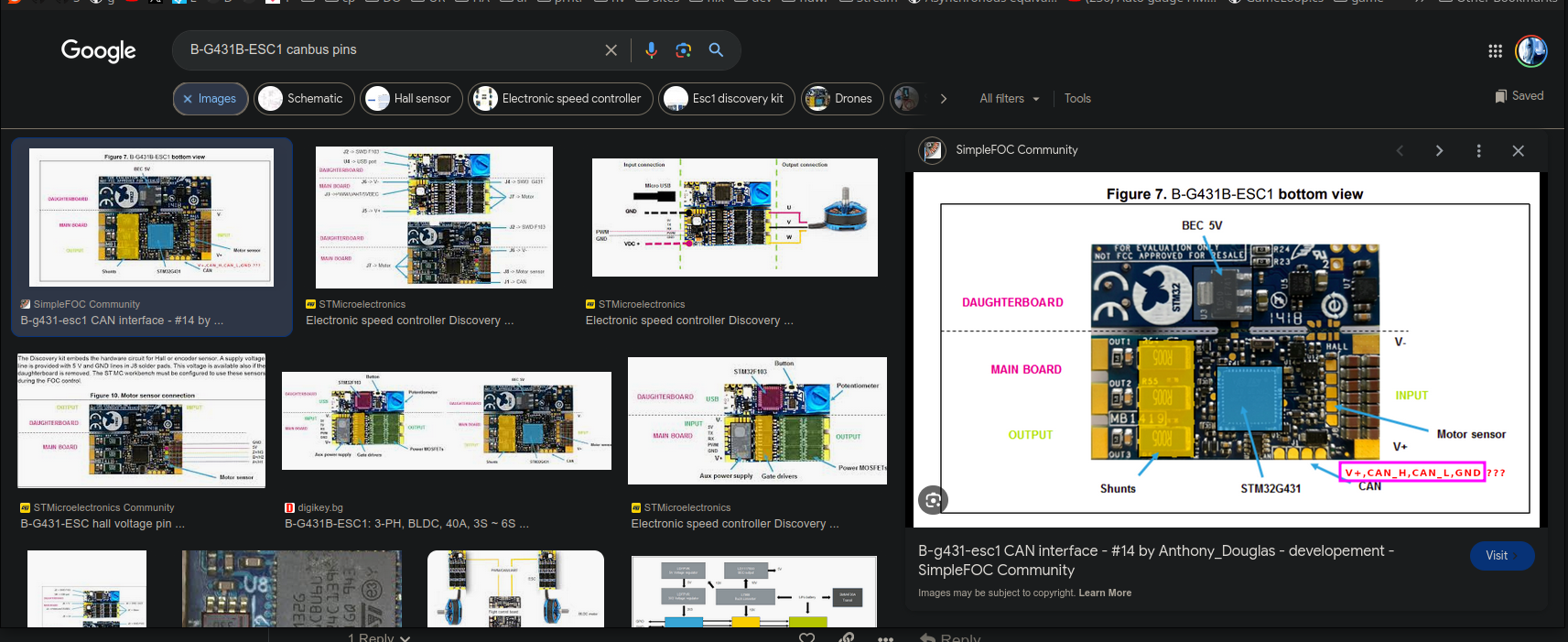In principle, your concept should work, so let’s see what might be the problem. I see two major potential sources for the issue.
- Wireing and bus termination. Make sure that you have exactly two ends of the bus terminated with 120 Ohm. Also, make sure the CAN wires are not crossed.
- You use an ESP32-S3 variant, which differs quite a bit from the older MCUs. I updated my library just last week to support the S3, so maybe you are still using the older version?
What you may also try is to connect two of the ESC1 (if you have two, and make sure they have different IDs!). If these work, the problem is reduced to the ESP.

Hey there, I was trying out the sample and as far as I can tell, it seems to be working, but after a few iterations I end up getting an error of
CAN Error: Tx buffer overrun. You will have to forgive me, as this is my first attempt to use/learn anything CAN related, so I only know the absolute minimum in terms of troubleshooting this, or what could/may go wrong.I am currently using a Lilygo T4 s3 device with a Waveshare SN65HVD230 transceiver, then also a B-G431B-ESC1. They are connected via two 3 way lever connectors, with the third connection being connected to my USB device.
Below is the output that I was seeing via platformio terminal.
Serial Output
``` Started CAN (ESP32): initializing, Tx=14, Rx=13, Speed=10 CAN: BTR0.B.BRP=4 CAN: initialized. CAN: setting filter single ID & mask, Std Frame CAN (ESP32): Start CAN: started. Setting CAN bus termination via software not possible Setup done, random device ID is 34 (0x22) New Status= -- -- TS RS TCS TBS --- --- ECC=0x0, RxErrors=0, TxErrors=0, Other=0 Sending: 2.500 New Status= -- -- TS RS --- --- --- --- ECC=0x0, RxErrors=0, TxErrors=0, Other=0 Sending Pong Request int Sending: 2.500 Sending Pong Request int Sending: 2.500 Sending Pong Request int Sending: 2.500 Sending Pong Request int Sending: 2.500 Sending Pong Request int Sending: 2.500 Sending Pong Request int CAN Error: Tx buffer overrun Sending: 2.500 CAN Error: Tx buffer overrun Sending Pong CAN Error: Tx buffer overrun Sending: 2.500 CAN Error: Tx buffer overrun Request int CAN Error: Tx buffer overrun ```I am not sure if it is something with the device choice, or if this is expected, etc. I figured it was worth an ask, just in case I am doing something incorrectly without realizing it. I wanted to use the LilyGo as it is a touchscreen and I wanted to make a small test UI with a slider or something to see if I could control a motor via SimpleFOC running on the b-g431b over CAN, so I do hope it is not an issue with the device, but if it is, then it is what it is.
Thanks, -MH
Side note:
I wanted to see if I could use a USB CANable device I just received (I followed their steps to install CANdleLight firmware, as I saw some posts and it seemed that was the usual things people did) to better view what was going on using:
But this does not show any sort of activity. I had tested it on it's own using an example I saw of how to write to the bus:
cansend can0 999#DEADBEEFand I saw that show up on cansniffer, so I imagine that means it's working, but that is somewhat unrelated (unless I need to listen with settings specific to what the example sends?)